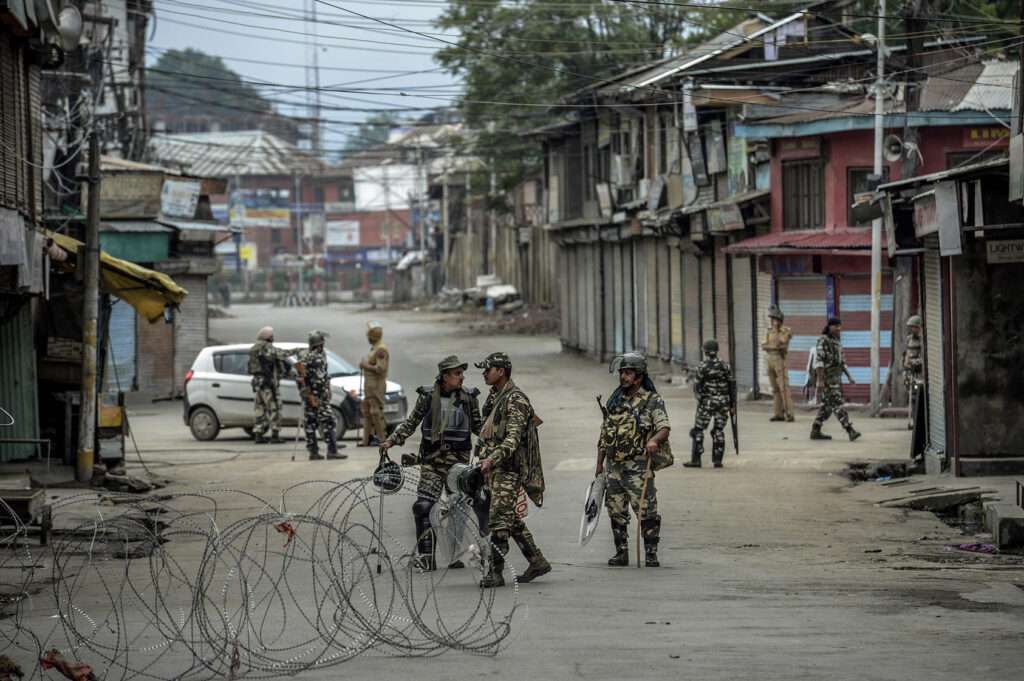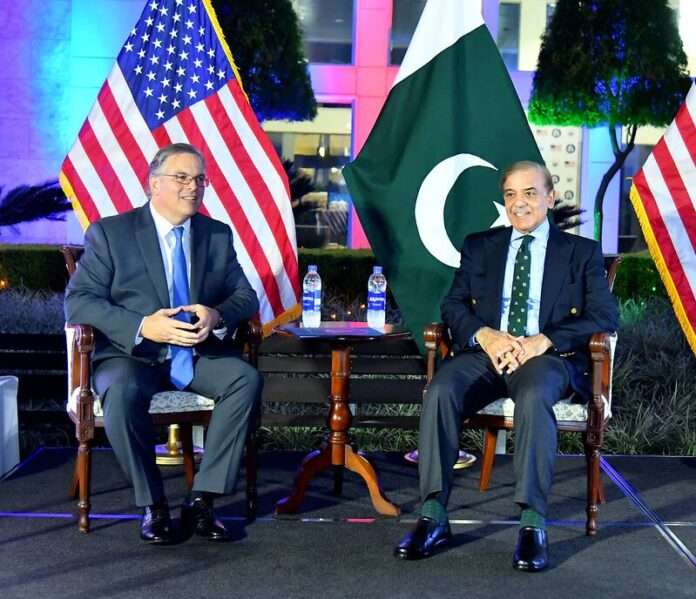The completion of seventy-five years of bilateral cooperation between Washington and Islamabad gave rise to a brief round of celebration between the US and Pakistan. Leaders of both states formally conveyed to the international community their determination for exploring new dimensions of bilateral cooperation while celebrating the long history of their cooperative interaction. Diplomatic officials of the two states have always remained active in performing their constructive functions even during difficult times and uncertain situations. Compared to the Washington-based Pakistani diplomatic authorities, the role of the US diplomatic mission in Islamabad has explored different avenues of collaboration in the social and economic sectors. This interaction in respective areas have resulted in multileveled cooperation between both nations parallel to keeping their respective governments politically well-coordinated. The political communication between the two increased their ties and established social and economic collaboration between both. The societal ties explored various avenues of people-to-people contacts, whereas the economic collaboration provided several trading platforms to their business communities. It can thus easily be maintained that the history of cooperative ties has connected the political, social, and economic values of both states allowing the two government authorities to remain in a close alliance against the potential challenges of international power politics. While keeping in mind the saga of decades-long cooperation, one must comprehend the nature of collaborative interaction, a prerequisite to identifying the role of potential challenges in defining the directions of an interstate interaction between Pakistan and US.
The nature of the decades-long multileveled collaboration between Islamabad and Washington can be measured in the era of Cold War politics when the government of Pakistan decided to join the American side against the inevitable pressure of international power politics under the capitalist and communist divisions of the international system. The bipolar divisions of the Cold War politics propelled American state officials to consider Pakistan an appropriate ally in the South Asian region, where India preferred to adopt a policy of non-aligned alignment and decided not to join the American alliance. The practical orientations of Pakistan’s role in the greater American alliance moved Pakistani state authorities towards multilateral defensive arrangements of the US. The joining of two American defence pacts, the Southeast Asia Treaty Organization (SEATO) and the Central Treaty Organization (CENTO) confirmed Pakistan as a declared American ally in the bipolar world designs of international politics. The subsequent developments in the growing Pak-US defence collaboration gave ruse to Moscow’s concerns about Pakistan when the incident of the U-2 spy plane cemented Pakistan as a strong American ally and a significant defence partner in the South Asian region. Pakistan’s role in American foreign policy increased during the Cold War politics when the US state authorities decided to improve their foreign relations with China, here the Pakistani leadership play a central role. Pakistan’s government helped the US improve diplomatic and economic ties with China. The active role of Pakistan ended a brief diplomatic isolation and political non-communication between the US and China and facilitated both countries to initiate cooperation against the prevailing threats of great power politics. The end of bipolar designs of international politics placed the international system under American leadership and allowed the US introduce its unipolar global designs, which resulted in a closer Pak-US strategic collaboration. The major shift in the strategic dimensions witnessed a new era of Washington-Islamabad cooperation when the government of Pakistan opted to join the American global designs of the war on terror. This was a US response to the tragic event of 9/11 when the US declared its global counterterror campaign, and Pakistan became the frontline state in the US-led Global War on terror. Further improvements in the Washington-Islamabad cooperative ties granted Pakistan the status of a non-NATO ally and encouraged Islamabad to facilitate Washington in its Afghanistan-specific counterterror operations. Akin to these progressive measures, Pakistan played a productive and constructive role in the Doha peace agreement, also known as the US-Taliban peace deal. Apart from these developments, the cooperative bilateral framework between both states witnessed various initiatives in diverse areas such as culture, education, human rights, and disaster management.

Despite having multilayered collaboration in several areas, the quest for securing the future of enhanced bilateral cooperation always remained a serious challenge for the governments of both states. Leading state authorities have always faced different challenges at social, political, economic, and strategic levels; these challenges have created an inescapable trust-deficit environment between Pakistan and US, and it has underestimated both governments’ vision for exploring new platforms for different joint ventures. Thus, a brief overview of the potential challenges widening the existing gaps in the fundamental framework of cooperative bilateralism between Washington and Islamabad is essential to understand, parallel to celebrating the history of successful interstate cooperation. The debate of prevailing mistrust between Washington and Islamabad can be measured with the help of certain points. The conceptual description of the Pak-US diplomatic alignment is essential to understand because the evolution of cooperative bilateralism between Pakistan and the US is actually a response to regional and global pressures. The regional pressures of the South Asian regional security environment for Pakistan and the forces of international power politics for the US shaped the existing collaboration patterns between Washington and Islamabad. This factor created active political communication and dynamic diplomatic support of both states and convinced them to understand their standing on various international issues. For Pakistan, the regional pressures of South Asian regional power politics are connected to the Indian role in its domestic region and the anti-Pakistani policy of New Delhi. The second factor in disturbing the cooperative matrix of Pakistan-US ties is the Indian presence in the broader geostrategic calculations of Washington because American state officials have recognized India as a close strategic partner without estimating the impact of this strategic partnership on the politics of the nuclearized subcontinent. It has raised Islamabad’s apprehensions about the scope of strategic stability in the South Asian nuclear order in the presence of persistently evolving Indian strategic connections with the US.
Islamabad’s consideration for the status of regional strategic stability in South Asia has become an unignorable feature of Pak-US relations because Washington’s presence in the regional strategic affairs of nuclearized subcontinent generally shapes the India-Pakistan strategic competition. Islamabad-based strategic community is generally intended to support the scope of strategically stable regional politics of nuclearized South Asia with the support of Washington, whereas the ongoing pattern of American South Asian policy has Indian-inclined designs. Thus, the increasing strategic collaboration between Washington and New Delhi has raised several questions of Islamabad on the American quest for enhancing and diversifying its strategic engagement with India. The constantly evolving tendencies of Indo-US strategic partnership have inflicted a sense of insecurity in Islamabad’s strategic calculations. The government of Pakistan has started raising its voices on the negative impacts of Washington’s strategic support for New Delhi while expecting the US to play the role of an impartial extra-regional player in the intense security environment of the South Asian region. Under the increasing influences of extra-regional powers, the role of China in South Asian regional political affairs has gradually become an essential feature of the India-Pakistan conflict. The increasing diplomatic association and trading collaboration between Beijing and Islamabad has disturbed the stance of India and the United States in the greater Asian political order, where New Delhi and Washington have viewed Beijing’s arrival in the nuclearized subcontinent as a serious threat to their geostrategic interests. The increasing criticism of India and the US on the evolving Pakistan-China economic cooperation and the signing of the China-Pakistan Economic Corridor (CPEC) between Beijing and Islamabad has hampered the cooperative foundations of Pakistan-US ties. America’s increasing anxieties about the evolving economic collaboration between China and Pakistan have resulted in a close strategic partnership between India and the United States, and it has marginalized the role of Islamabad in the broader American South Asian policy. Other than all these critical points, the Kashmir issue has always remained a gravitational point of Pakistan’s foreign policy. Pakistan’s government is trying to address the Kashmir issue peacefully with the help of the international community, in which the United States could play a decisively balanced role. The strategic and commercial engagement of India with the US has affected the status of Kashmir in the South Asian policy of Washington, in which the American state officials appear to be determined to play an active role in addressing the Kashmir issue without upsetting their strategic connections with New Delhi. Akin to the Kashmir issue, the Pakistani political authorities hold similar feelings for the sufferings of the Palestinian people living under Israeli occupational forces, where the Middle Eastern designs of US foreign policy could play a productive role. The actual concerns of Pakistan about the miserable conditions of the Muslim populations living in Kashmir and Palestine it that it expects Washington to emphasize on the peaceful settlement on both issues based on less theoretical and more practical measures. The attachment of the Pakistani government to the suffering of Muslim populations is primarily linked to the ideological foundations of Pakistan. Pakistan’s strong association with the Islamic ideology and an overwhelming wave of American criticism on the ideological attributes of the Pakistani state structure also disturbed the Pak-US cooperative interaction while increasing Pakistan’s anxieties.

Based on the above mentioned scenario, the debate on the history of seventy-five years of cooperation between Washington and Islamabad must be wary about the role of potential challenges which have become major hurdles in impeding the existing framework of Pak-US cooperative bilateralism. This article has provided a brief overview of US-Pakistan cooperation at the bilateral level parallel to understanding the potential challenges for both states based on a brief historical analysis. With the help of analyzing seventy-five years of history, the governments of both states can perhaps improve the existing patterns of their bilateral cooperation by adopting a more pragmatic approach; this will lead the mainstream policymaking circles of both states toward rational policy making mechanisms for improvement of bilateral collaborations in different dimensions. The US reluctance to address the major hurdles mentioned herein is intended to undermine the future bilateral plans of both nations. Paying heed to towards the above mentioned issue will not only improve the contemporary designs of cooperation between Washington and Islamabad, it will also let the American authorities to achieve desired results of their South Asian engagement. Moreover, the US response to the actual challenges of the South Asian security environment and the peaceful resolutions of the various issues between New Delhi and Islamabad will facilitate Washington in ensuring the values of peace and stability in the nuclearized subcontinent. Therefore, the recent exchange of several celebratory messages/meetings between the mainstream political authorities of both states has recalled the major joint accomplishments of two-sided governments in different fields without evaluating the main hurdles that impede the vision of bilateral cooperation. Historically, the two governments, under different political administrations, have always preferred to remain diplomatically supportive, politically coordinated, socially cooperative, and economically collaborative with each other. The actual problems originate from the gaps between policy formulation and its practical implementation at the bilateral level. Thus, it is required that the two have substantial consideration for the potential challenges to their bilateral cooperative interaction while celebrating the completion of seventy-five years.





